CDPs inform people-based marketing, which we’re all about here at HubSpot — putting the customer at the center of our flywheel. I’ll show you how CDPs can help your organization do the same.
What's a Customer Data Platform?
A customer data platform (CDP) is a software that aggregates and organizes customer data across a variety of touchpoints and is used by other software, systems, and marketing efforts. CDPs collect and structure real-time data into individual, centralized customer profiles.
According to the CDP Institute, a vendor-neutral organization dedicated to helping marketers manage customer data, a CDP is “a packaged software that creates a persistent, unified customer database accessible to other systems.”
Customer data platforms build customer profiles by integrating data from various first-, second-, and third-party sources. These include your CRM and DMP, transactional systems, web forms, email and social media activity, website and ecommerce behavioral data, and more.
How Does a Customer Data Platform Work?
A customer data platform pulls data from various sources across your organization and consolidates it into a unified view. I like to think of it as a centralized hub that takes customer data and translates it into a customer story, which helps you understand where customers are in their journeys and how you can help.
Here’s how it works:
1. Data Collection
Your CDP collects customer data from all available data streams, including website visits, CRM interactions, emails, and in-store interactions. The data is organized into a single place for identity resolution and organization into unique customer profiles.
2. Data Processing
Once all of your customer data has been gathered, it needs to be correctly associated with the appropriate customer account in a process called “identity resolution.” Your CDP will clean, deduplicate, and structure the incoming data to ensure each customer can be identified accurately and uniquely.
As I mentioned earlier, your CDP collects data from disparate sources, so resolving that data down to unique customer accounts is no walk in the park. Your CDP will link identifying information from your known customers (such as email or phone number) with browsing data like cookies and device IDs. Doing so creates a complete customer profile, with access to behavioral data that shows customer interactions before they shared their email/phone and officially became customers.
3. Segmentation and Activation
After your CDP has distilled your data into complete customer profiles, you can start the fun part: segmentation. Segmentation means organizing and breaking down your customer profiles based on your data. You can use attributes like behaviors, demographics, purchase history, and more. The sky’s the limit with your customer data platform. You can segment your customer data based on any data points collected in your CDP, which makes it easy to target specific audiences.
Finally, your customer data platform will connect to your marketing tools, allowing you to act on the insights and segmentation data. Data from your CDP will enable you to deliver personalized marketing campaigns that reach the right people at the right time.
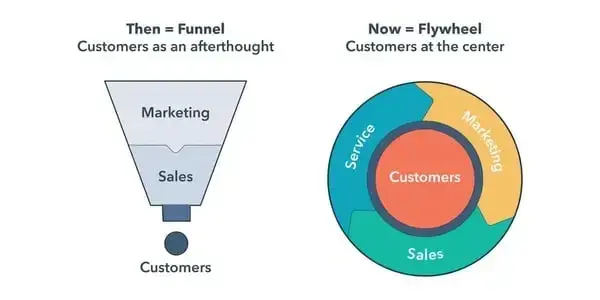
What Is Customer Data?
CDPs exist because customer data has become crucial to business and marketing operations. So, what is customer data exactly?
Customer data is information consumers leave behind as they use the internet and interact with companies online and offline through websites, blogs, ecommerce portals, and in-store interactions. When I visit a website and submit a form, I’m sharing more data than just my name and email. In addition to the information I provide (identity data), organizations can collect my device ID, activity information like clicks and page views, and much, much more.
It’s precious to businesses, although legal dialogue (such as the GDPR) has changed how organizations collect and manage this data.
CDPs collect and organize four main kinds of customer data.
1. Identity Data
Identity data builds the foundation of each customer profile in a CDP. This data type allows businesses to uniquely identify each customer and prevent costly replications. Identity data includes:
- Name information, such as first and last name.
- Demographic information, such as age and gender.
- Location information, such as address, city, and zip code.
- Contact information, such as phone number and email address.
- Social information, such as X (Twitter) handle and LinkedIn address.
- Professional information, such as job title and company.
- Account information, such as company-specific user IDs and account numbers.
2. Descriptive Data
Descriptive data expands on identity data and gives you a fuller picture of your customer. The categories of descriptive data will vary based on the type of company.
For example, a car dealership may collect lifestyle details about their customers’ cars, whereas a diaper company would collect information on the number of children in customers’ families. Descriptive data includes:
- Career information, such as previous employers, industry, income, and job level.
- Lifestyle information, such as the type of home, vehicle, and pet.
- Family information, such as the number of children and marital status.
- Hobby information, such as magazine subscriptions and gym memberships.
3. Quantitative or Behavioral Data
Quantitative data allows businesses to understand how each customer has engaged with their organization, whether through specific actions or transactions. Quantitative data includes:
- Transaction information, such as the number and type of purchased or returned products, the number of abandoned carts, and order dates.
- This information also includes RFM analysis: Recency (How recently did this customer make a purchase?), Frequency (How often does this customer make a purchase?), and Monetary value (How much does this customer spend on a purchase?)
- Email communication information, such as email opens, email click-throughs, email responses, and dates.
- Online activity information, such as website visits, website click-throughs, product views, and social media engagement.
- Customer service information, such as communication dates, query details, and service representative details.
4. Qualitative Data
Qualitative data provides context for customer profiles; it gives customer data personality. This type of data illuminates motivations, opinions, or attitudes expressed by customers. Qualitative data includes:
- Motivation information, such as How did you hear about us? Why did you purchase this? What made you choose this product over others?
- Opinion information, such as How would you rate this product? How would you rate our customer service? Or How likely are you to recommend us?
- Attitude information, such as favorite color, animal, textile, or food.
As you can see, CDPs collect and organize various data. It’s important to note that much of the specific data and categories will vary based on your business and industry.
Next, before we dive into what a CDP is, let’s clarify what a CDP is not.
Here are a few key differences between a CDP and a CRM.
- CDPs collect data on anonymous visitors, whereas CRMs only report on known customers or potential customers.
- CDPs analyze lifetime customer behavior and customer journeys, whereas CRMs primarily analyze the sales pipeline and forecasting.
- CDPs track online and offline customer data, whereas CRMs cannot detect offline data unless manually entered.
- CDPs are built to handle multiple data points from many sources, meaning the potential for replicated or lost data is slim. On the other hand, CRMs collect individually-entered data that can get lost or mislabeled if not handled correctly.
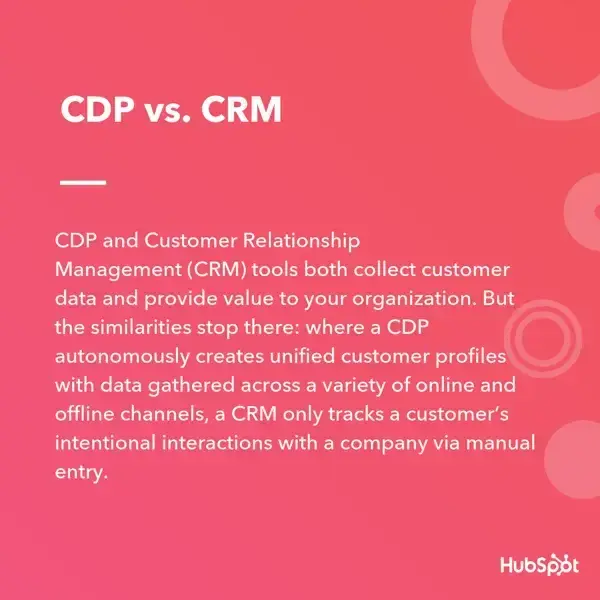
Pro tip: If you use both a CRM and a CDP, it is important to prioritize data hygiene and ensure consistency and accuracy between both systems. Regular cleaning and deduplication of data is necessary to prevent errors in analysis and reporting.
My take: CDPs are valuable for mapping the customer journey and identifying gaps in engagement. Meanwhile, CRMs are more commonly used to nurture customer relationships and manage specific interactions.
Here are a few key differences between a CDP and a DMP.
- CDPs influence all types of marketing, whereas DMPs mainly influence advertising to better target ads and reach audiences.
- CDPs collect mostly first-party data (direct from the source), whereas DMPs collect mostly third-party data (through data providers, managers, and services).
- CDPs reflect personalized, specific customer identifiers (like name, email address, and customer ID), whereas DMPs reflect anonymous customer identifiers (like cookies, etc.)
- CDPs retain data over a long period to build in-depth, accurate customer profiles and nurture relationships. In contrast, DMPs retain data for a short period to target ads and create lookalike audiences.
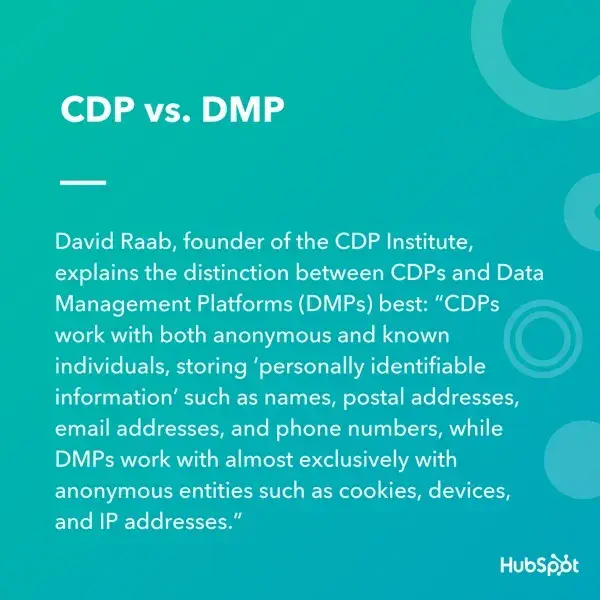
Pro tip: As third-party cookies get phased out, CDPs will become increasingly valuable compared to DMPs for gathering first-party data with explicit consent.
Whew … there are a lot of acronyms in the world of marketing, aren’t there? I hope I’ve helped you keep them all straight.
Let’s dive deeper into why you might consider purchasing a CDP for your organization.
Key Benefits of a CDP
CDPs improve your organization, improve your relationships, and complement your current software and marketing efforts. Here are a handful of key benefits of having a CDP.
CDPs Avoid Data Silos
- Data silos refer to data that is available to one department but isolated from the rest of an organization. Silos negatively affect the collaborative environment, slow the pace and productivity of your organization, and threaten the accuracy of your customer profile data.
- CDPs avoid data silos by unifying your customer data in a centralized location that all necessary teams can access.
Pro tip: Make sure your CDP integrates with your existing tools and data infrastructure, or else you won’t be able to eliminate silos.
I like the perspective of Peter Reinhardt, CEO of Segment: “Every single person in a company needs access to customer data in some form. The marketing team needs customer data for analytics and attribution. The sales team needs customer data in a CRM to close deals faster. Finance and operations teams need customer data to understand payment patterns and buying behavior.
The customer data platform is the key piece of infrastructure that makes it possible to actually collect and use customer data consistently across all teams and tools.”
CDPs Collect First-Party Data
- First-party data is data you gather directly from your customers and visitors, making it privacy-compliant and direct from the source.
- Examples of first-party data include information customers may provide on a form, such as their name, email, and address.
- First-party data also includes browsing data gathered via pixels and other tracking tools.
- First-party data is valuable for guiding strategic marketing and audience targeting decisions.
CDPs Help You Get to Know Your Customers
To enact customer-centered marketing, you must know your customers.
- CDPs allow you to build customer profiles that inform customer behavioral analysis and help construct identity graphs.
- CDPs provide deeper insights into customer needs through customer journey mapping and identity resolution.
- Identity resolution is the process of connecting a person’s disparate digital interactions to create a unified profile, and it is a pillar of CDP functionality.
→ Free Download - Customer Journey Mapping Template
CDPs Unify Cross-Channel Marketing Efforts
Your organization likely has multiple marketing efforts happening simultaneously. CDPs unify and democratize the data that powers your marketing campaigns, making collaborating across teams and channels simple.
- CDPs unify multi- and cross-channel marketing efforts by supplying consolidated, accurate data.
- Since CDPs can consolidate data from multiple channels, you can streamline campaign management and create more personal, engaging marketing experiences.
Pro tip: You can take advantage of your CDPs ability to track data across channels to identify which marketing initiatives are making the most significant impact.
How To Choose A CDP
When I’m in the market for anything, software especially, I insist on reading online reviews and demoing the product before I make any purchasing decisions. Choosing the right CDP is subject to the same scrutiny, and then some, if you ask me. Here are some things to consider when selecting your customer data platform.
1. Define your needs.
First and foremost, you need to list all the goals you hope to accomplish with your CDP. Are you looking to improve customer segmentation, enable personalized marketing, enhance customer insights, or simply warehouse your customer data? In my experience, having clear goals and defining must-have features simplifies the initial whittling-down process.
Plenty of CDP options are available on the market, so I recommend narrowing them down by eliminating those that lack the features you desire or are too robust for your needs.
Pro tip: Before you go down the rabbit hole, be sure you are looking for a CDP solution, not a CRM. Both are similar platforms, but CDPs are more specialized. More on that to follow.
2. Asses your data sources.
Identify all of the data sources that will be feeding into your customer data platform. For example, I have a small business with minimal data sources. My website, HubSpot CRM, and social media would be the only data sources for my CDP, so I do not need a robust, expensive option.
However, suppose you have data scattered over multiple platforms, including unstructured data, live chat tools, ad platforms, and customer information from in-person interactions. In that case, you may need a more comprehensive solution to handle multiple integrations and APIs.
Pro tip: Certain CDPs specialize in data integration, so if your data is fantastically scattered, look for an option like Segment that specializes in clean-up.
3. Consider ease of implementation.
CDPs can be complex, so much so that some people dedicate their entire careers to becoming experts in managing and implementing them. While some CDPs are aimed at highly technical users, others are more accessible. I recommend assessing your needs and resources to determine the best CDP for your team. When choosing your customer data platform, you should also consider the training and ongoing maintenance that will be required.
Pro tip: Don’t neglect the free trial, and don’t be afraid to call your CDP’s customer support if you need help testing out the product. You’ll be glad to choose a CDP with reliable support.
4. Evaluate privacy and compliance needs.
Customer data is serious stuff. I believe we owe customers the utmost honesty and the highest level of security when they entrust us with their data. Accordingly, you should select a customer data platform that complies with the California Consumer Privacy Act (CCPA) and the European Union’s General Data Protection Regulation (GDPR).
Pro tip: I also recommend choosing a CDP that can easily adapt to future privacy regulations. That way, you are never caught with your pants down if regulations change.
5. Consider scalability.
If you expect your business to grow, which I hope it does, your data management needs will also increase. I recommend seeking a CDP that can scale with your business by offering high-volume data storage or flexible plans that support its growth.
Pro tip: Customer data platforms are expensive, so I recommend waiting to invest in one until you have both the budget and the need.
→ Looking for a smart CRM that combines customer data with AI? Check out the HubSpot Customer Platform.
6. Don’t forget about customer support.
As a former support rep at HubSpot, I’m a little biased. However, I think selecting a customer data platform that offers top-notch customer service and support is crucial. In my experience, getting acclimated to an entirely new software platform can be challenging. But having a support team who is genuinely invested in your success can make all the difference.
Pro tip: During your free trial, call the CDP’s support team to get an idea of their support quality.
Top CDP Software Providers
There are many CDPs out there for businesses of all shapes and sizes. So, I put together a rundown of some of the most popular options on the market to help you start your search.
1. Segment

Segment is a customer data platform from Twilio that can unify real-time customer interaction data to create personalized marketing experiences at scale. During my product demo, I was impressed with the platform’s CustomerAI recommendation engine, which uses machine learning insights from your data to provide tailored experiences and predictions of customer brand and product preferences.
Pricing: Available upon request.
Pro tip: Customer reviews indicate that while Segment is highly regarded as a CDP, it is expensive, and the integration process with existing databases can be cumbersome.
2. Emarsys
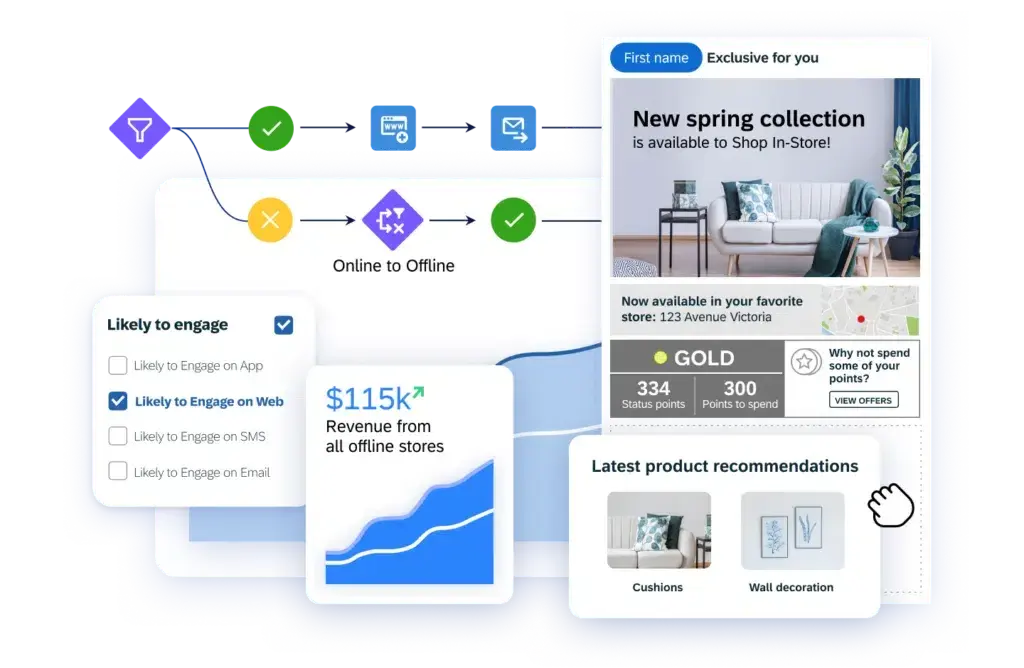
Emarsys helps marketers deliver AI-powered, personalized messaging across all marketing channels through data unification. As an SAP product, it has exceptional security and a robust feature set. I’m a fan of Emarsys’s extensive integration capabilities with advertising and ecommerce platforms, making connecting existing data to your CDP quick and easy.
Pricing: Available upon request.
Pro tip: Emarsys is expensive, so there may be better choices for small businesses. However, larger enterprises and existing SAP users can benefit from the robust features and tight integration with SAP products.
3. Bloomreach
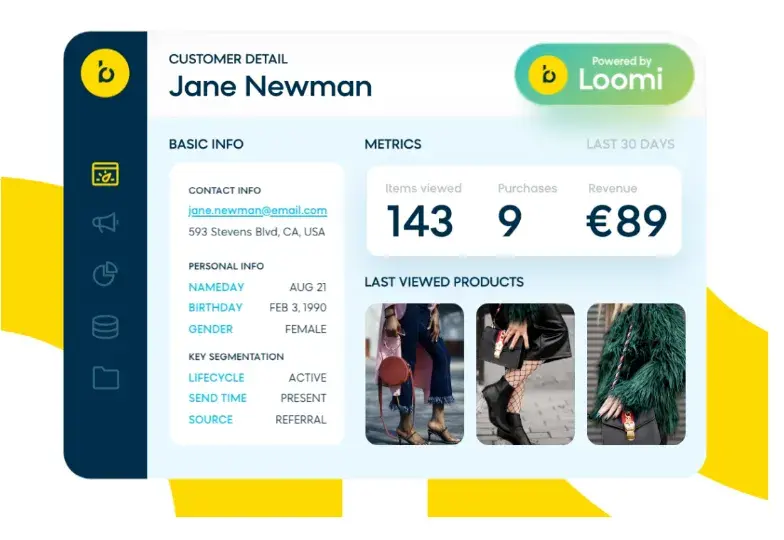
Formerly Exponea, Bloomreach is a customer data platform designed for ecommerce businesses. It’s easy to use and has a powerful data engine that unifies customer information and helps you uncover what customers really want. Bloomreach’s capabilities are amplified by Loomi, their proprietary ecommerce AI solution.
During my demo, I was impressed with Loomi’s capabilities to identify the best channel for reaching a specific customer. It can also intelligently suggest the best time of day for personalized outreach.
Pricing: Available upon request.
Best for: Ecommerce businesses looking to leverage their KPIs and make data-driven decisions.
4. Optimove
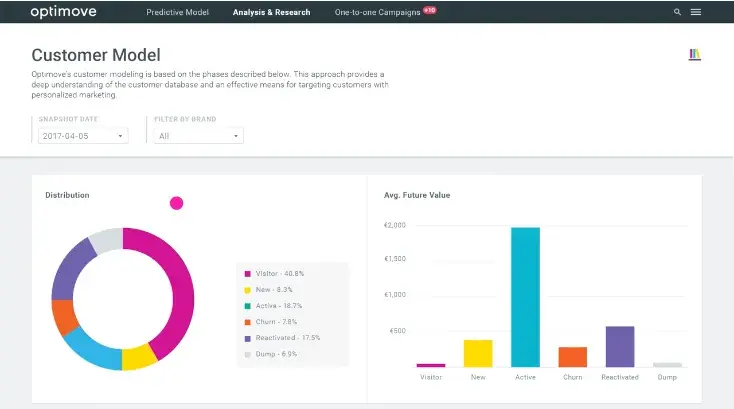
Optimove offers easy access to customer data and insights by aligning all customer data channels into a single customer engagement hub. The result? The ability to create hyper-targeted and personalized campaigns, all of which are organized in an attractive, easy-to-use calendar view for scheduling and activation. Optimove customers are assigned a dedicated customer success manager to provide expert support and guidance whenever needed.
Pricing: Available upon request.
What I like: I was impressed by the AI-powered predictive analytics features, which can display crucial customer retention metrics like projected customer value and churn risk.
5. Tealium

To round out our list of top customer data platforms, we have Tealium, my favorite of the bunch. Tealium is a sophisticated CDP that enables marketers to consolidate data from various sources and gain real-time insights for enhanced personalization and campaign optimization. I like Tealium because of its attractive, intuitive, and clean interface.
Like most CDPs, getting started has a learning curve, but once you’ve got the hang of it, it’s smooth sailing. Specifically, I found that creating audience profiles using attributes in Tealium was a pleasure. With a dedicated customer success team and a penchant for the highest echelon of privacy and security, Tealium is a customer data platform you can rely on.
Pricing: Available upon request.
What I like: Tealium offers more than 1,300 integrations that can connect your systems and data out of the box. Customer reviews have also indicated excellent product documentation.
Note: As you may have noticed, none of the CDPs listed here provide pricing information upfront. That’s because they typically charge based on data volume. You can expect a minimum investment of about $5,000/month for a proper CDP.
Where to Search for CDP Service Providers
Think a CDP may help your organization? I agree! There are many benefits to using a CDP to learn about and market to your customers. Here, I’ve gathered a few reliable sources from which to pull some CDP software options to consider for your team.
- CDP Service Provider Directory by CDP Institute. This list features “firms that provide CDP-related consulting, implementation, agency service, data, and technology.” Some of these companies are also CDP Institute Partners.
- The Best Customer Data Platform (CDP) Software Rankings by G2 Crowd. Like many of G2’s unbiased review pages, you can filter the results by the size of your organization and star rating. You can also sort the results by satisfaction, popularity, and G2 Score.
- The Best Customer Data Platform Software Rankings by Capterra. Capterra provides various filter options to help you narrow your CDP options, including pricing, popular features, users, and deployment.
- Gartner Magic Quadrant™ for Customer Data Platforms. This extensive research report provides a detailed overview of today’s CDP landscape. Gartner rates CDP vendors on two criteria: completeness of vision and ability to execute, making for an exciting analysis in a clean, graphical format.
- The Forrester Wave™ Customer Data Platforms for B2C Report. Similar to the Gartner report, Forrester comprehensively analyzes its 12 top CDP providers in a detailed research report, available for $2,995.
Pro tip: Sometimes I find it more useful to speak with actual users as opposed to scouring research reports. Don’t be afraid to reach out to CDP users or consultants for personalized recommendations based on your goals and data infrastructure.
Customer Data = Customer-Driven Marketing
Without customers, you wouldn’t have a business. I firmly believe that customers belong at the center of everything we do, especially our marketing. To place them front and center, we need real, raw customer data.
Customer data platforms enable us to create seamless, personalized marketing experiences for customers while guiding businesses through the complexities of today’s digital interactions. Check out the CDP software options above to take your marketing to the next level.
Editor's note: This post was originally published in March 2019 and has been updated for comprehensiveness.


.png)
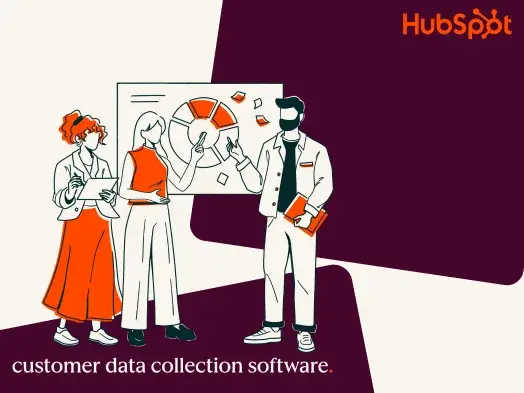

![Customer Data Integration: A Complete Guide [Expert Tips & Examples]](https://53.fs1.hubspotusercontent-na1.net/hubfs/53/customer-data-integration-1-20241218-9529716.webp)
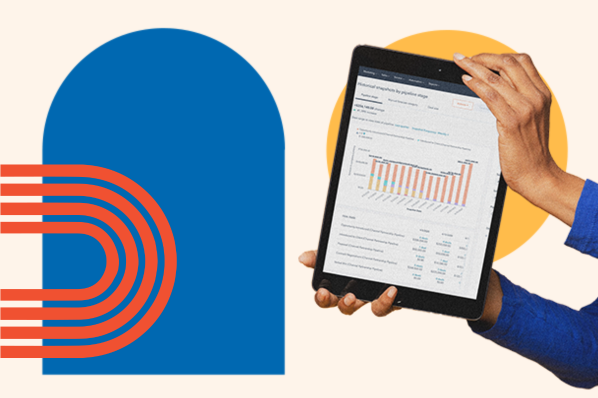





![What Is an Identity Graph? [The Plain-English Guide]](https://53.fs1.hubspotusercontent-na1.net/hubfs/53/identity-graphs.jpg)